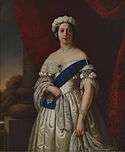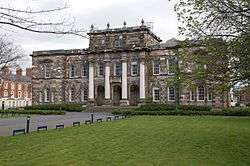Queen's University Belfast
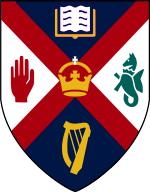 Coat of arms of Queen's University Belfast | |
| Latin: Universitas Reginae Belfastiae | |
| Motto | Pro tanto quid retribuamus |
|---|---|
Motto in English | For so much, what shall we give back? |
| Type | Public research university |
| Established |
1810 – R.B.A. Institution 1849 – Queen's College 1908 – University Status |
| Endowment | £65.4m (as of 31 July 2017)[1] |
| Budget | £337.6 million (2016-17)[1] |
| Chancellor | Vacant |
| Vice-Chancellor | Ian Greer |
| Visitor | HM The Queen |
Academic staff | 2,414[2] |
Administrative staff | 1,489[2] |
| Students | 23,850 (2016/17)[3] |
| Undergraduates | 18,795 (2016/17)[3] |
| Postgraduates | 5,055 (2016/17)[3] |
Other students | 2,250[4] (Colleges) |
| Location |
Belfast, County Antrim, Northern Ireland, UK 54°35′3″N 5°56′5″W / 54.58417°N 5.93472°WCoordinates: 54°35′3″N 5°56′5″W / 54.58417°N 5.93472°W |
| Campus | Urban |
| Newspaper | The Gown |
| Colours |
Red and White |
| Nickname | QUB |
| Affiliations |
Russell Group ACU EUA Universities UK Universities Ireland |
| Website | Official Website |
 | |
Queen's University Belfast (informally Queen's or QUB) is a public research university in Belfast, Northern Ireland.[note 1] The university was chartered in 1845, and opened in 1849 as "Queen's College, Belfast".
The university forms the focal point of the Queen's Quarter area of the city, one of Belfast's six cultural districts. It offers academic degrees at various levels and across a broad subject range, with over 300 degree programmes available.[5] Its President and Vice-Chancellor is Ian Greer. The annual income of the institution for 2016–17 was £337.6 million of which £79.6 million was from research grants and contracts, with an expenditure of £325.1 million.[1]
Queen's is a member of the Russell Group of leading research intensive universities, the Association of Commonwealth Universities, the European University Association, Universities Ireland and Universities UK. The university is associated with two Nobel laureates and one Turing Award laureate.
History
Queen's University Belfast has its roots in the Belfast Academical Institution, which was founded in 1810, one of the United Kingdom's 10 oldest universities, and remains as the Royal Belfast Academical Institution.[6] The present university was first chartered as "Queen's College, Belfast" in 1845, when it was associated with the simultaneously founded Queen's College, Cork, and Queen's College, Galway, as part of the Queen's University of Ireland – founded to encourage higher education for Catholics and Presbyterians, as a counterpart to Trinity College, Dublin, then an Anglican institution.[6] Queen's College, Belfast, opened in 1849.[6] Its main building, the Lanyon Building, was designed by the English architect, Sir Charles Lanyon. At its opening, it had 23 professors and 195 students.[7] Some early students at Queen's University Belfast took University of London examinations.[8]
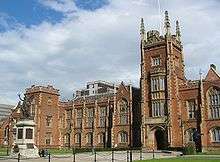
The Irish Universities Act, 1908 dissolved the Royal University of Ireland, which had replaced the Queen's University of Ireland in 1879, and created two separate universities: the current National University of Ireland and Queen's University of Belfast.[6]
Parliamentary representation
The university was one of only eight United Kingdom universities to hold a parliamentary seat in the House of Commons at Westminster until such representation was abolished in 1950. The university was also represented in the Parliament of Northern Ireland from 1920–1968, where its graduates elected four seats.
Modern day
On 20 June 2006, the university announced a £259 million investment programme focusing on facilities, recruitment and research.[9] One of the outcomes of this investment has been a new university library; the McClay library was designed by Boston-based architects Sheply, Bulfinch, Richardson & Abbott, working in association with Belfast architects, Robinson Patterson Partnership, and opened in July 2009. The building has been named in honour of Sir Allen McClay, a major benefactor of Queen's University and of the Library.[10]
In June 2010, the university announced the launch of a £7.5m Ansin international research hub with Seagate Technologies.[11]
Queen's is one of the largest employers in Northern Ireland, with a total workforce of 3,903, of whom 2,414 were members of academic, academic-related and research staff and 1,489 were administrative employees.[2]
Campus
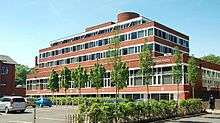
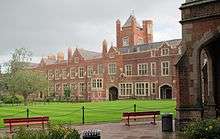
In addition to the main campus on the southern fringes of Belfast city centre, the university has two associated university colleges, St Mary's and Stranmillis located in the west and south-west of the city respectively. These colleges offer teacher training for those who wish to pursue teaching careers and a range of degree courses, all of which are centred around a liberal arts core.
While the university refers to its main site as a campus,[12] the university's buildings are in fact spread over a number of public streets in South Belfast, principally University Road, University Square and Stranmillis Road, with other departments located further afield.
Organisation and governance
Faculties and schools
Academic life at Queen's is organised into fifteen schools across three faculties. The three faculties are the Faculty of Arts, Humanities & Social Sciences, the Faculty of Engineering & Physical Sciences and the Faculty of Medicine, Health & Life Sciences. Each of the schools operates as a primary management unit of the university and the schools are the focus for education and research for their respective subject areas.[13]
- School of Biological Sciences
- School of Chemistry and Chemical Engineering
- School of Electronics, Electrical Engineering and Computer Science
- School of Arts, English and Languages
- School of History, Anthropology, Philosophy and Politics
- School of Law
- Queen’s Management School
- School of Mathematics and Physics
- School of Mechanical and Aerospace Engineering
- School of Medicine, Dentistry and Biomedical Sciences
- School of Nursing and Midwifery
- School of Pharmacy
- School of Natural and Built Environment
- School of Psychology
- School of Social Sciences, Education and Social Work
Other Academic Provision
- Gibson Institute- involved in education and research in the areas of sustainability, rural development, environmental management, food marketing, renewable energy, nutrition, physical activity and public health
- Institute for Collaborative Research in the Humanities – established in 2012, supports interdisciplinary research in the Humanities at all levels. On Feb 18th 2016 BBC Northern Ireland reported that this Institute was to be closed.[14]
- Institute for Global Food Security
- Institute for the Study of Conflict Transformation and Social Justice
- Institute of Cognition and Culture- Founded in 2004, this is one of the world’s first centres for research in the cognitive science of culture. It has brought together a range of cutting-edge cognitive scientists via a series of visiting fellowships.
- Institute of Electronics, Communications and Information Technology (ECIT)- established in 2003 to commercialise world-class research and expertise in a variety of enabling digital communications technologies at the School of Electronics, Electrical Engineering and Computer Science at Queen’s University Belfast.
- Institute of Irish Studies- It was the first of its kind to be established in the world and is one of the leading centres for research-led teaching in Irish Studies and is an internationally renowned centre of interdisciplinary Irish scholarship.
- Institute of Professional Legal Studies- established in 1977, it provides an internationally recognised and unique one-year postgraduate course for trainee barristers and trainee solicitors
- Institute of Spatial and Environmental Planning (ISEP)
- Institute of Theology- Consists of several colleges with a Christian emphasis, including St Mary's (Catholic), Union Theological College (Presbyterian), Belfast Bible College (non-denominational), as well as Baptist and Methodist colleges in Belfast. In all five colleges teach any programmes with a theological emphasis on behalf of the university; the university may confer theology degrees but cannot teach the subject itself.
- William J Clinton Leadership Institute-
Governance
Queen's has been led by a distinguished line of Vice-chancellors, including Sir David Keir, Lord Ashby of Brandon, Michael Grant, Sir Arthur Vick, Sir Peter Froggatt, Sir Gordon Beveridge, Sir George Bain and Sir Peter Gregson.[6] The current acting VC, James McElnay, was appointed in June 2017,[15] following the sudden death of the previous VC, Patrick Johnston.[16]
The university's Chancellors have included Anthony Ashley-Cooper, 9th Earl of Shaftesbury, Field Marshal Alan Brooke, 1st Viscount Alanbrooke, Sir Tyrone Guthrie, Eric Ashby, Baron Ashby,[17] and George J. Mitchell.[18] The current chancellor is the businessman Thomas Moran.
Academic profile
Research
Global rankings | ||
| ARWU[19] (2018) | 301-400 | |
|---|---|---|
| CWTS Leiden[20] (2018) | 238 | |
| QS[21] (2019) | 180= | |
| THE[22] (2019) | 201-250 | |
| Complete[23] (2019) |
36 | |
| The Guardian[24] (2019) |
52 | |
| Times / Sunday Times[25] (2019) |
38 | |
Queen's University Belfast was admitted as a member of the self-appointed Russell Group of UK research-intensive universities in November 2006.[26][27] It was ranked joint 42nd in the UK for the quality (GPA) of its research[28] and 19th for its Research Power in the 2014 Research Excellence Framework.[29] .[30]
Rankings and reputation
The Times Higher Education rankings 2018 placed Queen’s 32nd out of 93 in the UK. In the 2018 QS World University Rankings, Queen's was ranked 202.
In the National Student Survey 2013, Queen's was ranked 12th in the UK for student satisfaction.[31]
Queen's is ranked 202 in the world according to the 2018 QS World University Rankings. Research at the university includes investigations of cancer, sustainability, wireless technology, creative writing, pharmaceuticals, and sonic arts.[32] In 2016, the university ranked 36th in the UK according to the Complete University Guide.[33]
The university has been awarded the Queen's Anniversary Prize for Further and Higher Education on several occasions, including for work in comprehensive cancer services and improving survival rates for patients in Northern Ireland. In 2015, Queen's was awarded the Queen's Anniversary Prize for work in the field of engineering and technology[34]
Admissions
| 2017 | 2016 | 2015 | 2014 | 2013 | |
|---|---|---|---|---|---|
| Applications[35] | 28,615 | 29,140 | 29,105 | 27,960 | 27,750 |
| Offer Rate (%)[36] | 86.0 | 85.2 | 86.1 | 86.6 | 85.2 |
| Enrols[37] | 4,445 | 4,435 | 4,290 | 4,530 | 4,520 |
| Yield (%) | 18.1 | 17.9 | 17.1 | 18.7 | 19.1 |
| Applicant/Enrolled Ratio | 6.44 | 6.57 | 6.78 | 6.17 | 6.14 |
| Average Entry Tariff[23][note 2] | n/a | 152 | 389 | 385 | 380 |
Entrants to Queen's have, on average, 359 A/AS-level points and there are currently 5.3 applications per place, although this is misleading because virtually all applicants come from Northern Ireland and most apply for multiple courses.[38] The Sunday Times has described the Queen's admissions policy as "among the most socially inclusive in Britain and Northern Ireland".[38] 99.5% of first degree entrants are from state schools,[39] although this is mainly due to the lack of private schools in Northern Ireland. The university gives offers of admission to 86.1% of its applicants, the 3rd highest amongst the Russell Group.[40]
In the 2016/17 academic year, the total student population was 23,850, of whom 18,795 were undergraduates and 5,055 postgraduates.[3] In the 2016-17 academic year, the university had a domicile breakdown of 87:4:9 of UK:EU:non-EU students respectively with a female to male ratio of 56:44.[41] There was also a total student population of 2,250 at the University's St Mary's and Stranmillis University Colleges as of 2013/2014.[4]
Queen's was established with the aim of attracting both Protestant and Catholic students. While the university does not publish data on the religion affiliation of its students, Rupert Taylor, who conducted his PhD research on the university during The Troubles, argued in an article published in 1988 that "Whilst in the past, especially before the Second World War, Catholics were under-represented this is not currently the case". Taylor cites data showing that Catholic representation amongst undergraduates rose from 21.9 per cent in 1958/59 to 27.4 per cent in 1968/69 and 42.5 per cent in 1978/79.[42] By the late 1990s, 54 per cent of Queen's students were Catholics, compared to a 48 per cent share of the Northern Ireland population aged 18–25.[43] The growing share of Catholics in the student population is in part due to the tendency of middle-class Protestants to go to university in Great Britain rather than Northern Ireland.[42]
In 2009, Queen's signed a joint venture partnership with INTO University Partnerships, creating INTO Queen's University Belfast. The INTO centre is based on campus and provides a foundation year for international students who want to study at the University.[44]
Student life
Students' Union
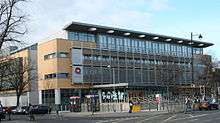
The Students' Union at Queen's (QUBSU) is located opposite the Lanyon Building on University Road, and is provided for under the University's Statutes. All students at the University are automatic members of the Union, making it one of the largest Unions on a single campus in Ireland and the UK. It is administered by the Students' Representative Council (SRC) (elected every October, on a Faculty basis) and an Executive (elected in March), who manage the operations of the Union in conjunction with several full-time staff.
The current Union building is to close at the end of August 2018, with demolition scheduled for March 2019, marking the beginning of a 3 year process of rebuilding the Union building. Interim facilities are being provided in other university buildings and, for the Union bars, a newly acquired space on the Lisburn Road (opposite the Medical Biology Centre).
Union services
A range of services are provided by the Students' Union including an Advice Centre with full-time staff to help with issues such as money problems, accommodation and welfare. Commercial services are also provided for by the Union and include a shop, canteen and coffee franchise. There are also four bars within the building, the biggest of which, the Mandela Hall, hosts numerous concerts each year as well as the majority the Students' Union's club nights.
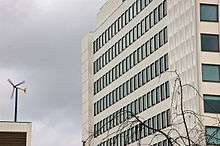
Clubs and societies
More than fifty sporting clubs and over one hundred non-sporting societies are recognised by the Student's Union Council and therefore eligible to apply for an annual grant from the University.[45] The oldest society in Queen's University is the Literary and Scientific Society which focuses on debating political, cultural and social issues within Northern Ireland. Established in 1850 by Edwin Lawrence Godkin, the society has been very successful and produced some of the finest orators within Northern Ireland. The Dragonslayers Gaming Society hosts one of Ireland's largest games conventions, Q-Con, in June of each year, and cultural groups such as An Cumann Gaelach and the Ulster-Scots Society are also present.
The Queen's University Mountaineering Club is notable for producing three Everest summiteers including Ireland's first, Dawson Stelfox.[46] Roger McMorrow and Nigel Hart also summited in May 2007, and were subsequently jointly announced Queen's University Graduates of the year for 2006/07[47] for their role in rescuing a young Nepalese climber left for dead near the summit.[48]
QUB is one of only 20 Universities in the United Kingdom to have the privilege of an AIESEC Local Chapter, developing leadership, business and soft skills in highly motivated students, as well as providing international opportunities through their work abroad program.
Housing
Queen's provides housing for both undergraduates and postgraduates, although because of the compact size of Northern Ireland many students chose to live at home and commute. In 2005/06, 36% of Queen's students lived in private accommodation within Belfast, 29% lived with parents or guardians, 20% in private accommodation outside of Belfast, and 10% lived in university maintained accommodation.[49] The university provides accommodation on a purpose-built 'student village' called Elms Village, which has its own bar and shop, located on the Malone Road, south of the main campus, as well as in a number of houses in the South Belfast area, including at College Gardens and on Mount Charles.[50]
Cultural life
The university had hosted the annual Belfast Festival at Queen's since 1961 but announced in March 2015 that it would not continue to fund the festival.[51]
It runs the hugely successful Queen's Film Theatre, described as Northern Ireland's leading independent cinema,[52] the Brian Friel Theatre and an art gallery, the Naughton Gallery at Queen's, which is a registered museum.[53] In 2008 the Naughton Gallery was awarded the Times Higher Award for Excellence and Innovation in the Arts.[54] Housed in the Lanyon building since 2001 is a marble statue by Pio Fedi of the great physicist Galileo, portrayed deep in thought.[55]
Sport

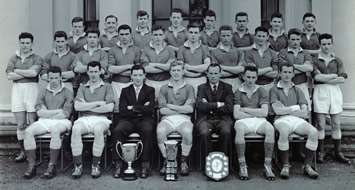
Queen's Physical Education Centre (abbreviated to and known widely as the PEC) recently went through an extension program was awarded 'Best Building 2007' by the Royal Institute of Chartered Surveyors (RICS) Northern Ireland.[56] It is one of the largest sports centres in the British Isles. This building houses many squash courts, several climbing walls and is home to QUB's senior men's and women's basketball teams.
The University Playing Fields, also known as Malone Playing Fields, is located just over 2 miles (3.2 km) from the main campus, comprising 17 pitches for rugby, association football, Gaelic football, hockey, hurling, camogie and cricket. In addition, there are three netball courts, nine tennis courts and an athletics arena where the Mary Peters Track is situated. The area and its surrounding forest of Barnetts Demesne are mapped for orienteering.
The university's association football team, Queen's University Belfast A.F.C., play in the Irish Second Division. Queen's snooker team have won the British intervarsity title on a record nine occasions and are the current champions.[57]
Queen's University Belfast Boat Club is one of the most successful clubs in the University. The QUB boathouse, home of Queen's University Belfast Boat Club (QUBBC) and Queen's University of Belfast Ladies Boat Club (QUBLBC), is located on the River Lagan near Stranmillis. In 2010 they were reigning Irish Champions in men's Intermediate and Senior 8's. They are also reigning Irish University Champions in Men's Senior 8's, Women's Novice 8's and Women's Novice 4's.[58] They are the only rowing club in Ireland to have a full-time rowing coach.[59]
Visual identity
The graphic identity, which includes the logotype, was originally created in 2000 by Lloyd Northover, the British design consultancy founded by John Lloyd (graphic designer) and Jim Northover. This identity was updated in 2011 by Belfast-based brand consultancy, Mammoth. Queen's visual identity was redesigned again in October 2017, also by Mammoth[60], replacing the 'Q' identity with an updated version of the university's crest.
Notable alumni and academics

Queen's has a large number of now-famous alumni, including former President of Ireland Mary McAleese; Nobel Prize winners poet Seamus Heaney and politician Lord Trimble; former Prime Minister of Northern Ireland Lord Faulkner of Downpatrick; Lords Chief Justice of Northern Ireland, Lord Hutton and Lord Kerr of Tonaghmore, Justice of The Supreme Court of United Kingdom; former Speaker of the Northern Ireland Assembly Lord Alderdice and former and current Northern Ireland ministers Sir Reg Empey, Mark Durkan, Nigel Dodds and Conor Murphy, and former Irish Free State minister and prominent Sinn Féin member Eoin MacNeill. Irish Ambassador to Nigeria Sean Hoy graduated from Queen's.
Other alumni include poet Paul Muldoon; actors Liam Neeson and Stephen Rea; comedian and presenter Patrick Kielty; novelists Patrick Hicks and Brian McGilloway; broadcasters Nick Ross and Annie Mac; journalist Chris Smith; scientists John Stewart Bell, Frank Pantridge and Thomas Henry Flewett. Other alumni include John Bodkin Adams, Trevor Ringland and David Cullen (2007 winners of the Arthur Ashe for Courage Award), David Case (Air Commodore, the highest ranking Black officer in the British Armed forces) and Tim Collins (former Commanding Officer of the 1st Battalion, Royal Irish Regiment). Drew Nelson Current Grand Secretary of the Orange Order
Notable academics who have worked at Queen's include Paul Bew, Baron Bew, Sir Bernard Crossland, Tony Hoare, Michael Mann, poet and critic Philip Hobsbaum, John H. Whyte and poet Philip Larkin was a sub-librarian at the university in the early 1950s.
Four alumni had very long and distinguished careers in the Far East. Sir Robert Hart was the Inspector-General of China's Imperial Maritime Customs for almost 50 years. Sir Hiram Shaw Wilkinson served in British Consular Service in China and Japan for 40 years retiring as Chief Justice of the British Supreme Court for China and Corea. Sir James Russell was Chief Justice of Hong Kong. John Carey Hall served in the British Japan Consular Service for more than 40 years retiring as consul-general in Yokohama.
Links with other universities
In 2014, Queen's announced the opening of China Medical University – Queen's University Belfast Joint College (CQC), a partnership between Queen’s School of Pharmacy and China Medical University (CMU) in Shenyang, Liaoning Province. CMU, had a long-standing relationship with the Queen's University's School of Pharmacy at Queen's prior to the joint college. Queen's also has links with Shenzhen University, which began in 1998 and continues to prepare approximately 40 students per year for a degree at Queen's.
Queen's participates in the European Union's ERASMUS programme, allowing undergraduate students to study for a period at universities in Austria, Finland, Iceland, Portugal, Belgium, France, Italy, Slovakia, Bulgaria, Germany, the Netherlands, Spain, the Czech Republic, Greece, Norway, Sweden, Denmark, Hungary, Poland and Switzerland.[61] Queen's is also part of the Utrecht Network which works towards the internationalisation of higher education. The university also has exchange programmes with Fordham University School of Law in New York, USA, the University of Newcastle and the University of Tasmania in Australia, and two universities in Canada: Queen's University in Kingston, Ontario, and the University of Alberta in Edmonton, Alberta.[62] Ching Yun University in Zhongli District, Taoyuan City, Taiwan, lists Queen's as a 'sister institution'.[63] The university is also a member of the Top Industrial Managers for Europe (T.I.M.E.) Association.
Queen's takes part in the British Council's Business Education Initiative study-abroad scheme sending a number of undergraduate students to study business and related subjects at participating higher-education institutions in the United States.[64][65]
See also
References
Notes
- ↑ The university's official title, per its charter, is The Queen's University of Belfast.
- ↑ New UCAS Tariff system from 2016
Footnotes
- 1 2 3 "Financial Statements for the Year to 31 July 2017" (PDF). Queen's University Belfast. p. 35. Archived from the original (PDF) on 22 December 2017. Retrieved 19 December 2017.
- 1 2 3 Vice-Chancellor's Report 2009 – 2010 (PDF). Queen's University Belfast. 2010. Archived from the original (PDF) on 21 August 2011.
- 1 2 3 4 "2016/17 Students by HE provider, level, mode and domicile" (CSV). Higher Education Statistics Agency. Retrieved 25 March 2018.
- 1 2 "Table 1 – All students by HE institution, level of study, mode of study and domicile 2009/10". Statistics Online. Higher Education Statistics Agency. Retrieved 8 July 2011.
- ↑ "Teaching Quality". Queen's University Belfast. Archived from the original on 17 April 2008. Retrieved 4 March 2008.
- 1 2 3 4 5 "History of Queen's". Queen's University Belfast. Retrieved 1 March 2008.
- ↑ Moody, T.W.; Beckett, J.C. (1959). Queen's, Belfast 1845-1949 : the history of a university. London: Faber & Faber for the Queen's University of Belfast. p. 661.
- ↑ "Student lists". Senate House Library. Archived from the original on 14 September 2010. Retrieved 4 April 2013.
- ↑ "Queen's invests £259 million in 'world-class future'". Queen's University Belfast. 20 June 2006. Retrieved 16 September 2006.
- ↑ "New library update – 27 July 2009". Library News. Queen's University Belfast. 27 July 2009. Archived from the original on 15 August 2009. Retrieved 10 August 2009.
- ↑ "Queen's opens £7.5m Ansin tech centre". Insideireland.ie. 8 June 2010. Retrieved 17 June 2010.
- ↑ See http://www.qub.ac.uk/home/TheUniversity/Location/Maps/MainCampus/, for example.
- ↑ "Schools & Departments". Queen's University Belfast. Archived from the original on 28 August 2008. Retrieved 28 August 2008.
- ↑ "Queen's University to close department that organised Charlie Hebdo event". BBC News. Retrieved 2016-02-18.
- ↑ Alumni, Queen's (16 June 2017). "Prof James McElnay, PVC Research, Enterprise & Postgrad Affairs, appointed Acting President and Vice-Chancellor @QueensUBelfast @QUBFoodProfpic.twitter.com/tWcnDi0jHB".
- ↑ "Obituary: Prof Patrick Johnston - a great mind whose work saved lives". Belfast Telegraph. 5 June 2017. Retrieved 16 June 2017.
- ↑ Brian Walker and Alf McCreary (1994). Degrees of Excellence: The Story of Queen's, Belfast, 1845–1995. Belfast: Queen's University Belfast. p. 213. ISBN 0-85389-535-X.
- ↑ Clarkson, L. A. (2004). A university in troubled times : Queen's Belfast, 1945–2000. Dublin [u.a.]: Four Courts Press. p. 195. ISBN 1-85182-862-1.
- ↑ "Academic Ranking of World Universities 2018". Shanghai Ranking Consultancy. Retrieved 15 August 2018.
- ↑ "CWTS Leiden Ranking 2018 - PP top 10%". CWTS Leiden Ranking 2018. Retrieved 16 May 2018.
- ↑ "QS World University Rankings 2019". Quacquarelli Symonds Ltd. Retrieved 6 June 2018.
- ↑ "World University Rankings 2019". Times Higher Education. Retrieved 26 September 2018.
- 1 2 "University League Table 2019". The Complete University Guide. Retrieved 26 April 2018.
- ↑ "University league tables 2019". The Guardian. 29 May 2018. Retrieved 29 May 2018.
- ↑ "The Times and Sunday Times University Good University Guide 2019". Times Newspapers. Retrieved 23 September 2018.
- ↑ "The Russell Group appoints first Director General and expands membership to 20 top research universities". Russell Group. November 2006. Archived from the original on 11 March 2008. Retrieved 1 March 2008.
- ↑ "Queen's to join UK 'ivy league'". BBC News. 7 November 2006. Retrieved 1 March 2008.
- ↑ "Research Excellence Framework results 2014" (PDF).
- ↑ "REF 2014 results". The Guardian. Retrieved 24 March 2015.
- ↑ "research excellence work 2014". 18 December 2014.
- ↑ "INTO Queen's University Belfast". INTO Higher. Archived from the original on 7 April 2014. Retrieved 19 January 2014.
- ↑ "Queen's University Belfast". Top Universities. Retrieved 2016-01-05.
- ↑ "Top UK University League Tables and Rankings 2016". www.thecompleteuniversityguide.co.uk. Retrieved 2016-01-05.
- ↑ "Previous Prize-winners". www.royalanniversarytrust.org.uk. Retrieved 2016-01-05.
- ↑ "End of Cycle 2017 Data Resources DR4_001_03 Applications by provider". UCAS. 2017. Retrieved 25 January 2018.
- ↑ "Sex, area background and ethnic group: Q75 Queens University Belfast". UCAS. 2017. Retrieved 25 January 2018.
- ↑ "End of Cycle 2017 Data Resources DR4_001_02 Main scheme acceptances by provider". UCAS. 2017. Retrieved 25 January 2018.
- 1 2 Sunday Times University Guide, Queen's University Belfast, 10 September 2006. Retrieved 16 January 2007.
- ↑ "More state pupils in universities". BBC News. 19 July 2007. Retrieved 24 July 2007.
- ↑ "Which elite universities have the highest offer rates". The Telegraph. Retrieved 21 October 2016.
- ↑ "Where do HE students study?". Higher Education Statistics Authority. Retrieved 9 February 2018.
- 1 2 Taylor, Rupert (1988). "The Queen's University of Belfast: The liberal university in a divided society". Higher Education Review. 20 (2): 27–45.
- ↑ Clarkson, Leslie A (2004). A University in Troubled Times: Queen's, Belfast, 1945–2000. Dublin: Four Courts Press.
- ↑ intohigher.com accessed 5 September 2011
- ↑ Clubs and Societies, Queen's University website. Retrieved 15 July 2007.
- ↑ "Mr Dawson Stelfox". Open University. Archived from the original on 26 June 2007. Retrieved 15 June 2008.
- ↑ "Past Graduate & Student of the Year winners". Queen's University Belfast. Retrieved 15 June 2008.
- ↑ "BBC: NI doctors in Everest rescue drama". BBC News. 29 May 2007. Retrieved 15 June 2008.
- ↑ "Supplementary Document 1: Housing Market Analysis, Houses in Multiple Occupation (HMOs): Subject Plan for Belfast City Council Area 2015" (PDF). The Planning Service. p. 14. Retrieved 26 August 2007.
- ↑ "Where to stay at Queen's" (PDF). Queen's Accommodation and Hospitality. Archived from the original (PDF) on 11 September 2008. Retrieved 3 September 2008.
- ↑ "Queen's University withdraws funding for Belfast Festival blaming cuts to public purse - BelfastTelegraph.co.uk". Retrieved 12 January 2017.
- ↑ "Friday People with head of Queen's Film Theatre, Susan Picken". Belfast Telegraph. 9 May 2014. Retrieved 9 December 2015.
- ↑ "About Us". Archived from the original on 24 December 2016. Retrieved 12 January 2017.
- ↑ "THE Awards 2008: shortlist". 25 September 2008. Retrieved 12 January 2017.
- ↑ "Queen's University Belfast Architectural Heritage Trail" (PDF). Queen's University Belfast. p. 5. Archived from the original (PDF) on 13 June 2011. Retrieved 1 December 2010.
- ↑ "Queen's Physical Education Centre scoops top building award". Queen's Sport. 8 June 2007. Archived from the original on 3 September 2007. Retrieved 27 December 2007.
- ↑ Results History; British Universities & Colleges Sport – Snooker – Championships; retrieved August 2010
- ↑ "home". Queen's University Belfast Rowing. Retrieved 17 June 2010.
- ↑ "Queen's University Belfast | Press Releases". Qub.ac.uk. Retrieved 17 June 2010.
- ↑ "Mammoth". Queens University Belfast. Retrieved 2017-10-28.
- ↑ "ERASMUS partners 2007–08". Queen's University Belfast. Retrieved 9 March 2008.
- ↑ "University exchange programmes". Queen's University Belfast. Archived from the original on 30 October 2007. Retrieved 9 March 2008.
- ↑ "清雲科技大學與外國學校(含學術機構)簽署學術交流合作協約". Ching Yun University. Archived from the original on 21 February 2008. Retrieved 9 March 2008.
- ↑ "Prospective students". British Council Northern Ireland. Archived from the original on 22 October 2008. Retrieved 3 September 2008.
- ↑ "Business Education Initiative". Queen's University Belfast. Archived from the original on 26 March 2009. Retrieved 3 September 2008.
Further reading
- Clarkson, L. A. University in Troubled Times: Queen's, Belfast, 1945-2000 (2004) 226pp.
External links
- Official Queen's University Belfast website
- Queen's University Belfast Students' Union
- Queen's University Belfast Research Portal
| Wikimedia Commons has media related to Queen's University Belfast. |
